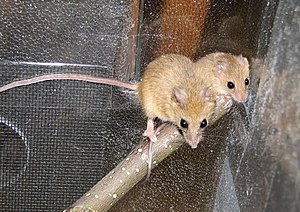African climbing mice
| African climbing mice | ||||||||||||
|---|---|---|---|---|---|---|---|---|---|---|---|---|

Dendromus mystacalis |
||||||||||||
| Systematics | ||||||||||||
|
||||||||||||
| Scientific name | ||||||||||||
| Dendromus | ||||||||||||
| A. Smith , 1829 |
The African climbing mice or eel line climbing mice ( Dendromus ) are the most common and best-known genus of the tree mice (Dendromurinae).
Most species are characterized by a single black vertical stripe on the back; The exception here is the Lovat climbing mouse, which has three stripes. Otherwise the fur is gray or brown on the top and white or yellowish on the underside. The length of the head body varies between 5 and 10 cm, plus a 7 to 13 cm long tail.
species
The number of species fluctuates depending on the doctrinal opinion. While 28 species were originally described, Bohmann summarized them as early as 1942 to only four species. Since then, different species lists have been presented by different authors. In the Mammal Diversity Database of the American Society of Mammalogists (2018) and in the Handbook of the Mammals of the World (2017) 14 species are currently recognized, in the IUCN Red List there are 13 species, since there Dendromus leucostomus was synonymous with Dendromus melanotus .
- Subgenus Chortomys
- Lovat-climbing mouse , Dendromus Lovati , Ethiopia
- Subgenus Poemys
- Nyika climbing mouse , Dendromus nyikae , Central and South Africa
- Gray climbing mouse , Dendromus melanotis , all of sub-Saharan Africa
- Lachaise climbing mouse , Dendromus lachaisei , Guinea , Liberia and Ivory Coast
- Subgenus Dendromus
- Cameroon climbing mouse , Dendromus oreas , Cameroon
- Brant climbing mouse , Dendromus mesomelas , eastern and southern Africa
- Kivu Climbing Mouse , nyasae Dendromus , Rwenzori Mountains
- Vernay's climbing mouse , Dendromus vernayi , Angola
- Mountain climbing mouse , Dendromus insignis , East Africa
- Maroon climbing mouse, Dendromus mystacalis , East, Central and South Africa
- Banana climbing mouse , Dendromus messorius , West, Central and East Africa
- Kahuzi climbing mouse , Dendromus kahuziensis , eastern Democratic Republic of Congo
- Rupp climbing mouse , Dendromus Ruppi , southwestern South Sudan .
Way of life
The climbing mice can best be compared with the dormouse . They prefer the open savannah as a habitat, whereby bushes and / or trees must be present. Only the chestnut climbing mouse inhabits dense forests. The Lovat climbing mouse, which shows no tendency to climb and lives on the ground, is also different.
As nocturnal animals , climbing mice sleep through the day either in underground burrows (subgenus Chortomys and Poemys ) or in spherical nests made from parts of plants that are laid out in bushes or trees (subgenus Dendromus ). Occasionally abandoned nests are also taken over by weaver birds or nectar birds , and the common eel-lined climbing mouse also builds its nest on thatched roofs or in gutters. At night they move agile through the branches looking for seeds, berries and insects and also eat eggs from bird nests.
While most species are very common, the Kahuzi climbing mouse and Vernay's climbing mouse are not. Vernay's climbing mouse has not been sighted since it was first described in 1937, and nothing is known about the status of this species. The Kahuzi climbing mouse is only known from two specimens, both of which come from Mount Kahuzi in the Ruwenzori Mountains ; this species is listed as critically endangered by the IUCN .
literature
- Ronald M. Nowak: Walker's Mammals of the World. 2 volumes. 6th edition. Johns Hopkins University Press, Baltimore MD et al. 1999, ISBN 0-8018-5789-9 .
- Ludwig Bohmann: The genus Dendromus A. Smith. Attempt of a natural grouping (results of the East Africa trip 1937 Uthmoller-Bohmann. VIII). In: Zoologischer Anzeiger. 1942, No. 139, ISSN 0044-5231 , pp. 33-53.
